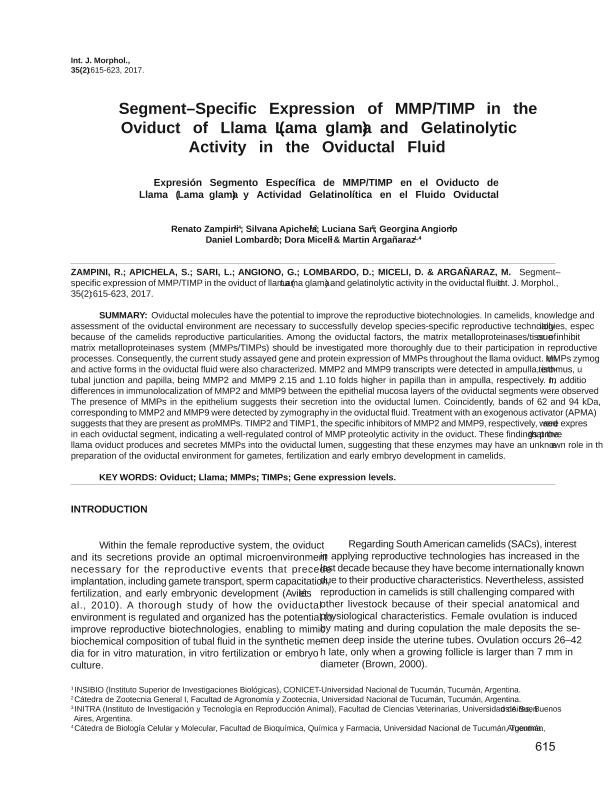Mostrar el registro sencillo del ítem
dc.contributor.author
Zampini, Renato

dc.contributor.author
Apichela, Silvana Andrea

dc.contributor.author
Sari, Luciana María

dc.contributor.author
Angiono, Georgina Melisa

dc.contributor.author
Lombardo, Daniel Marcelo

dc.contributor.author
Miceli, Dora Cristina

dc.contributor.author
Argañaraz, Martin Eduardo

dc.date.available
2018-08-01T22:15:25Z
dc.date.issued
2017-04
dc.identifier.citation
Zampini, Renato; Apichela, Silvana Andrea; Sari, Luciana María; Angiono, Georgina Melisa; Lombardo, Daniel Marcelo; et al.; Segment–specific expression of MMP/TIMP in the oviduct of llama (Lama glama) and gelatinolytic activity in the oviductal fluid; Sociedad Chilena de Anatomía; International Journal of Morphology; 35; 2; 4-2017; 615-623
dc.identifier.issn
0717-9367
dc.identifier.uri
http://hdl.handle.net/11336/53860
dc.description.abstract
Las moléculas oviductales tienen el potencial para mejorar las biotecnologías reproductivas. En los camélidos, debido a sus peculiares características reproductivas, el conocimiento del ambiente oviductal constituye una herramienta útil para el desarrollo de tecnologías reproductivas específicas para estas especies. Entre los factores oviductales de interés se encuentran las metaloproteasas de matriz (MMPs) y sus inhibidores específicos (TIMPs), los cuales han sido involucrados en diferentes procesos reproductivos. Por estas razones, en este trabajo se caracterizó la expresión génica y proteica de MMP2 y MMP9 en el oviducto de llama. Además, se analizó la presencia de las formas activas e inactivas (zimógenos) de estas enzimas en el fluido oviductal. Se observó que todos los segmentos oviductales, ámpula, istmo, unión útero-tubal y papila, expresan MMP2 y MMP9, siendo los niveles de expresión de MMP2 y MMP9 más elevados en papila respecto a ámpula; 2,15 y 1,10 veces respectivamente. Asimismo, se observaron diferencias en la distribución de las MMPs a nivel de la mucosa entre los segmentos oviductales. Consecuentemente, bandas con actividad gelatinolítica de 62 y 94 kDa, se detectaron en el fluido oviductal, las cuales corresponderían a las formas inactivas de la MMP2 y la MMP9, respectivamente. Los inhibidores específicos de MMP2 y MMP9; TIMP2 y TIMP1, también se detectaron en los segmentos oviductales, indicando su probable participación en la regulación de la actividad proteolítica de las MMPs en el oviducto de llama. En conjunto, los datos de este trabajo demuestran que el oviducto de la llama produce y secreta MMPs al lumen oviductal; sugiriendo que estas enzimas pueden participar en la preparación del ambiente oviductal para la recepción de los gametos, la fecundación y el desarrollo embrionario temprano en camélidos.
dc.description.abstract
Oviductal molecules have the potential to improve the reproductive biotechnologies. In camelids, knowledge and assessment of the oviductal environment are necessary to successfully develop species-specific reproductivetechnologies, especially because of the camelids reproductive particularities. Among the oviductal factors, the matrix metalloproteinases/tissue inhibitor of matrix metalloproteinases system (MMPs/TIMPs) should be investigated morethoroughly due to their participation in reproductive processes. Consequently, the current study assayed gene and protein expression of MMPs throughout the llama oviduct. MMPs zymogen and active forms in the oviductal fluid werealso characterized. MMP2 and MMP9 transcripts were detected in ampulla, isthmus, utero-tubal junction and papilla, being MMP2 and MMP9 2.15 and 1.10 folds higher in papilla than in ampulla, respectively. In addition, differences inimmunolocalisation of MMP2 and MMP9 between the epithelial mucosa layers of the oviductal segments were observed. The presence of MMPs in the epithelium suggests their secretion into the oviductal lumen. Coincidently, bands of 62 and 94 kDa, corresponding to MMP2 and MMP9 were detected by zymography in the oviductal fluid. Treatment with an exogenous activator (APMA) suggests that they are present as proMMPs. TIMP2 and TIMP1, the specific inhibitors of MMP2 and MMP9, respectively, were expressed in each oviductal segment, indicating a wellregulated control of MMP proteolytic activity in the oviduct. These findings prove that the llama oviduct produces and secretes MMPs into the oviductal lumen, suggesting that these enzymes may have an unknown role in thepreparation of the oviductal environment for gametes, fertilization and early embryo development in camelids.
dc.format
application/pdf
dc.language.iso
eng
dc.publisher
Sociedad Chilena de Anatomía
dc.rights
info:eu-repo/semantics/openAccess
dc.rights.uri
https://creativecommons.org/licenses/by-nc-sa/2.5/ar/
dc.subject
Oviducto
dc.subject
Llama
dc.subject
Mmps
dc.subject
Expresión Genética
dc.subject
Timps
dc.subject.classification
Otras Ciencias Veterinarias

dc.subject.classification
Ciencias Veterinarias

dc.subject.classification
CIENCIAS AGRÍCOLAS

dc.title
Segment–specific expression of MMP/TIMP in the oviduct of llama (Lama glama) and gelatinolytic activity in the oviductal fluid
dc.title
Expresión Segmento Específica de MMP/TIMP en el Oviducto de Llama (Lama glama) y Actividad Gelatinolítica en el Fluido Oviductal
dc.type
info:eu-repo/semantics/article
dc.type
info:ar-repo/semantics/artículo
dc.type
info:eu-repo/semantics/publishedVersion
dc.date.updated
2018-07-30T13:49:34Z
dc.identifier.eissn
0717-9502
dc.journal.volume
35
dc.journal.number
2
dc.journal.pagination
615-623
dc.journal.pais
Chile

dc.journal.ciudad
Temuco
dc.description.fil
Fil: Zampini, Renato. Consejo Nacional de Investigaciones Científicas y Técnicas. Centro Científico Tecnológico Conicet - Tucumán. Instituto Superior de Investigaciones Biológicas. Universidad Nacional de Tucumán. Instituto Superior de Investigaciones Biológicas; Argentina. Universidad Nacional de Tucumán. Facultad de Bioquímica, Química y Farmacia; Argentina
dc.description.fil
Fil: Apichela, Silvana Andrea. Consejo Nacional de Investigaciones Científicas y Técnicas. Centro Científico Tecnológico Conicet - Tucumán. Instituto Superior de Investigaciones Biológicas. Universidad Nacional de Tucumán. Instituto Superior de Investigaciones Biológicas; Argentina. Universidad Nacional de Tucumán. Facultad de Agronomía y Zootecnia; Argentina
dc.description.fil
Fil: Sari, Luciana María. Consejo Nacional de Investigaciones Científicas y Técnicas. Centro Científico Tecnológico Conicet - Tucumán. Instituto Superior de Investigaciones Biológicas. Universidad Nacional de Tucumán. Instituto Superior de Investigaciones Biológicas; Argentina
dc.description.fil
Fil: Angiono, Georgina Melisa. Universidad de Buenos Aires. Facultad de Ciencias Veterinarias. Instituto de Investigacion y Tecnología en Reproducción Animal; Argentina
dc.description.fil
Fil: Lombardo, Daniel Marcelo. Universidad de Buenos Aires. Facultad de Ciencias Veterinarias. Instituto de Investigacion y Tecnología en Reproducción Animal; Argentina
dc.description.fil
Fil: Miceli, Dora Cristina. Consejo Nacional de Investigaciones Científicas y Técnicas. Centro Científico Tecnológico Conicet - Tucumán. Instituto Superior de Investigaciones Biológicas. Universidad Nacional de Tucumán. Instituto Superior de Investigaciones Biológicas; Argentina
dc.description.fil
Fil: Argañaraz, Martin Eduardo. Consejo Nacional de Investigaciones Científicas y Técnicas. Centro Científico Tecnológico Conicet - Tucumán. Instituto Superior de Investigaciones Biológicas. Universidad Nacional de Tucumán. Instituto Superior de Investigaciones Biológicas; Argentina. Universidad Nacional de Tucumán. Facultad de Bioquímica, Química y Farmacia; Argentina
dc.journal.title
International Journal of Morphology

dc.relation.alternativeid
info:eu-repo/semantics/altIdentifier/url/http://www.intjmorphol.com/wp-content/uploads/2017/06/art_38_352.pdf
dc.relation.alternativeid
info:eu-repo/semantics/altIdentifier/url/http://www.intjmorphol.com/es/resumen/?art_id=4264
Archivos asociados
